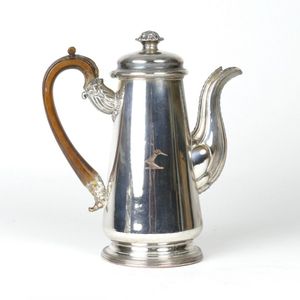Miniature Georgian Silver Tankard with Heart-Shaped Handle
You must be a subscriber, and be logged in to view price and dealer details.
Subscribe Now to view actual auction price for this item
When you subscribe, you have the option of setting the currency in which to display prices to $Au, $US, $NZ or Stg.
- Georgian - As an English stylistic period, Georgian is usually taken to cover the period from George I (1714) to the Regency of Prince George (1811-20), although the period from 1800 to 1830 is sometimes designated as the Regency period. During the Georgian period the great English cabinetmakers and designers such as Chippendale, Hepplewhite, Adam Sheraton etc., were all active.
Therefore there isn't a single 'Georgian style' as such and to say something is 'Georgian', usually means it was made between 1714 and 1830. This assumes we discount George V and George VI, both being from the 20th century.
The styles popular at the time of each reign were:
George I (1714-1727) saw out the last years of the Baroque period.
George II (1727-1760) reigned during the Rococo period.
George III (1760-1820) saw the last gasp of the Rococo, all of the early Neo-Classic 'Adam style' and most of the later neo-Classic 'Regency style'.
George IV (Prince Regent 1820-1830)encompassed the last of the 'Regency' style.
William IV's reign (1830-1837) was something of a no man's land (stylistically) and he wasn't a 'George' anyway. He covered the last glimmerings of 'Regency' and the start of the 'Victorian' style. - Tankard - A tankard is a drinking vessel for beer, ale, and cider, similar in shape to a large mug, and usually with a hinged lid. Silver tankards were in use in Britain and other parts of Europe from at least the sixteenth century, pewter tankards probably from the thirteenth. In the 19th century a number of ornately carved ivory tankards were produced, but these were designed to demonstrate the skill of the carver, rather than for day to day use. The shapes of tankards vary, sometimes globular, sometimes a tapering concave. For those with lids, the lid usually includes a thumbpiece that the drinker can hold down to keep the lid open. Variation in the design of the thumbpiece include wedge, ball and wedge, ball, hammer head, bud and wedge, double volute (scroll), chair-back, ball and bar, shell, double acorn, corkscrew, and ram's horn.
This item has been included into following indexes:
Visually similar items

A George II silver mug, tapering cylindrical shape with capped S-scroll handle, London 1746 probably by Thomas Whipham. 372gms.

An early Victorian silver tankard, one quart, plain traditional form with acanthus leaf thumb piece, Spencer family armorial to the front. Sheffield 1856 by Henry Wilkinson. Weight 814gms. Height 21 cm

A William IV silver mug, tapering cylindrical shape with scrolling handle, the handle terminal modelled as a pennant flag. London 1830 by William Bateman. Weight 375gms. Height 14 cm

A Georgian period crested Old Sheffield Plate coffee pot, conical with wood handle and flower finial. Height 23.5 cm.
